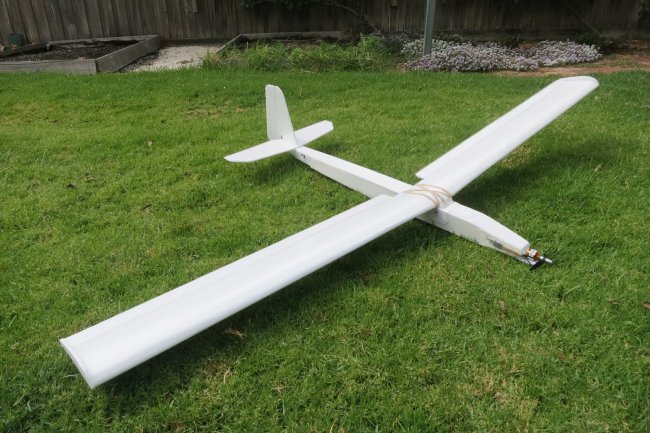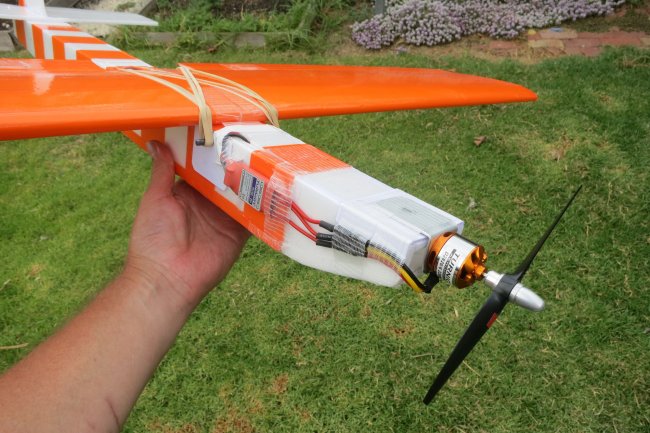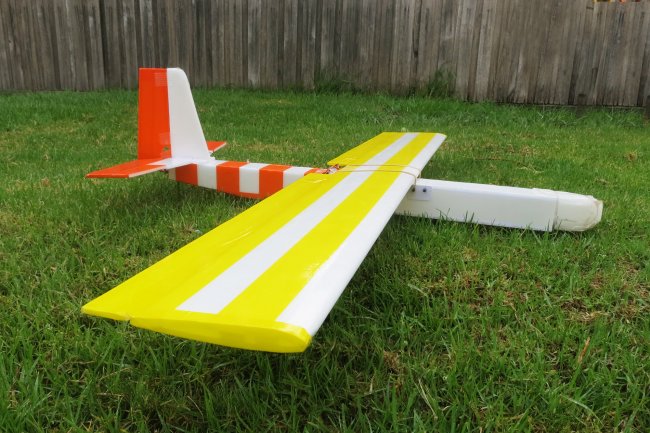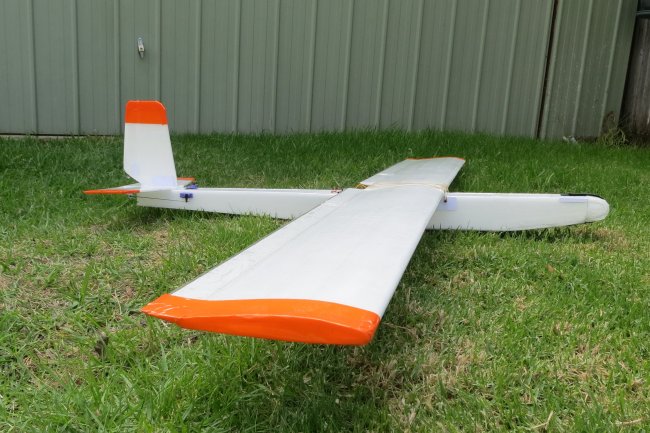What's the problem
In Australia we can't get Dollar Tree foamboard but there are some alternatives. I have settled on 6mm depron from Tradewarehouse as my favourite building material.
Inspired by the great reviews of the 2m Radian EP motor glider I wanted to build something similar using Experimental Airlines and Flite Test methods.
Here's what I came up with. 2m (79") wingspan, flying weight 750g (27oz).
It looked great but flew hoooooorribly. The plane would climb OK initially but then loop up and wobble when trying to fly level, even with the CG way forward and motor angled down. Then there was the glide slope, or lack of one. It continually stalled and just dropped out of the sky.

Wing loading was only 6.5oz/sq ft, and no amount of CG or thrust angle changes improved the stability. The wing wasn't flexing or twisting excessively.
The only variable left was airfoil shape. I started to suspect that my 5" airfoil was too fat. Following ExAir's Armin wing instructions but using 6mm depron and a 7.5mm spar, my version was ending up 26mm thick compared to Ed's 20mm. Back to the drawing board.
As a reaction to that disappointment the next wing I build was 1.2m and super slim, only 20mm thick and 6.5" airfoil with 1.5" ailerons. It flew beautifully, smooth and controllable and even glided really well. Big surprise.

Then, further encouraged, I made a symmetrical wing slope soarer with a slim airfoil. This one is 20mm thick and 5.5" airfoil plus 2" ailerons and it flies like magic. The tape covered depron tends to automatically bend into the symmetrical section, I just encouraged it by lifting the trailing edge of the bottom layer a little as it was glueing.
For a flat bottomed section you need to press the wing down flat while gluing.

The maximum thickness still looked too far forward comapred to production wings so the investigations continued.
Airfoil design
For inspiration I looked at the Bixler 2 wing, which glides beautifully, and the widely used Clark Y airfoil.
The key features are ... maximum thickness is less than 12% of the total chord and positioned 30% back from the leading edge.
I made up a variety of airfoil sections ranging in chord length (including ailerons) from 6.5" to 9.5" using my variation of ExAir's Armin wing. Explained below in more detail.

The combinations that most closely matched the Clark Y airfoil were:
A. 7.0" chord (5.5" plus 1.5" aileron) Spar 53mm back from the leading edge, no extra former over the spar.
B. 8.0" chord (6.5" plus 1.5" aileron) Spar 61mm back with a 3mm former layer over the spar.
C. 9.5" chord (7.5 plus 2" aileron) Spar 76mm back with a 6mm former layer over the spar.
To my eye these sections looked much nicer than my previous builds and a lot closer to commercially produced RC gliders and planes. Depron tends to kink rather than bend smoothly over the formers if the curve is too great but it's not a problem with these slimmer sections.
These have become my standard wing chord designs now. I would add larger 2" ailerons for aerobatic models, especially slope soarers. Varying degrees of airfoil section symmetry can be built-in by varying how much you press the wing down flat while gluing up.
Time to revisit the 2m wing. I made this one with a swappable nose section so it could be a slope soarer or motor glider.
This is a big success, my favourite sloper now, smooth, languid and majestic in the sky. It flies in winds ranging from 8kn to 25kn at my nearby slopes and behaves just as I hoped.

Wing construction
Here is my standard wing building method using 6mm unskinned depron and 7.5mm Skyshark P4X wrapped CF spars from kitesandfunthings. I'll make a video and add it here eventually.
Cover one side of the 6mm depron with packing tape. I have used PPS and Scotch tapes and prefer the cheaper PPS. There is no paper on depron so the tape is needed for strength and to achieve smooth bends. A few mm overlap between each tape run is all that's required.
Sand a 1" taper on the inside of the bottom trailing edge to conform with the top layer for gluing. I found it was better not to sand all the way down to the covering tape but to leave about 2mm thickness at the trailing edge. When glued down the trailing edge ends up 8mm thick which allows the aileron to better blend in to the overall airfoil shape.
For an accurate leading edge fold, make a slight dent line (with the other end of a pencil) along the inside surface. Don't make the dent too deep or you will end up with a very sharp leading edge.
Place the spar where you want the thickest part of the airfoil to be (like 30% back) and glue formers either side. I use 20mm wide lengths of depron with another 40mm layer on top of the spar depending on the chord length.
Links for materials and information
Experimental Airlines for designs and techniques
Tradewarehouse for bulk depron
Kitesandfunthings for CF spars
My website for underwater photography, kite aerial photography and RC flight













Log In to reply
Log In to reply
Its a bit cheaper and it also has a paper covering If you have already considered it why did you chose that one over the foamboard(i am considering between the 2)
Log In to reply
Log In to reply
Log In to reply
Be safe and have fun,
Tommy
Log In to reply
Log In to reply
I found that the only way I could get it to bend reliably along the right line along the length of the wing was to cut a groove where I wanted it to bend (i.e. leading edge, a little in front of the spar and just after the spar (assuming a single spar)) on the inside of the airfoil.
This worked but was very time consuming.
Log In to reply
Log In to reply
Log In to reply
Log In to reply
Haha! I just got the reference to David, our favorite Swede.
Log In to reply
Log In to reply
Log In to reply
I've built a similar(semi-symmetrical) wing for my version of the "Dusty" model, with promising results. The tendency to climb with minor speed changes, exhibited by the flat-bottomed airfoil, is gone(so much so, I'll have to take out the down-thrust on the motor).
Thank you for your contributions, and keep the good work coming!
Jeff.
Log In to reply
Flight characteristics? The curved bottom needs less elevator input for inverted, rolls are more axial.
One problem is that it's trickier to mount the wing flat on the fuselage, I needed to tilt the wing forward by adding packing under the trailing edge on my 2m motor glider.
Log In to reply
Log In to reply
With more experience I now think that original 2m dihedral motor glider wing was not level on the fuselage. I wish I had tried tilting it forward at the time.
Log In to reply
I want to ask how did you determine the angle where the fuselage started to get narrow?
Log In to reply
Log In to reply
A fork. No kidding!
It grooves excellent parallel patterns into Depron. This avoids the ugly edges over the spar.
I start at the dent for the leading edge and make 9-12 parallel dents on the Upper side, using a straight edge as a rule. If necessary I do 2 dents at the underside for a smooth beginning of the LE.
Log In to reply
Log In to reply